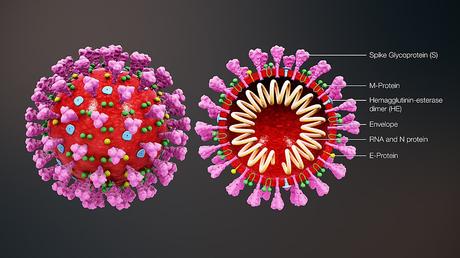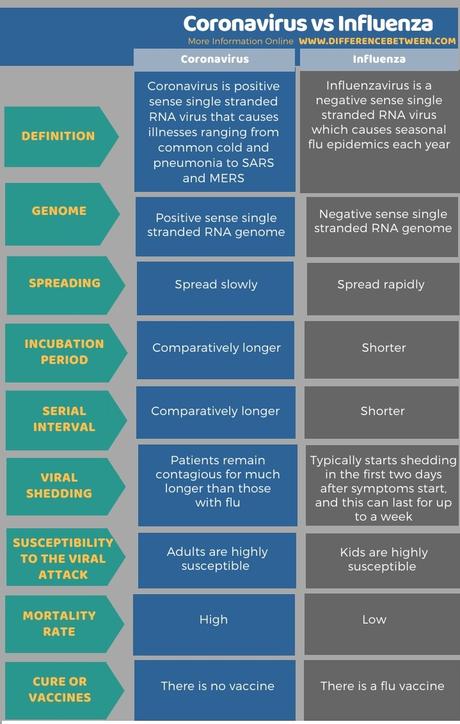Both attack the respiratory system of humans and show similar symptoms. However, coronavirus infection is more deadly than the influenza virus infection. Moreover, there is a vaccine for influenza infection while there is no vaccine for coronavirus yet.
What is Coronavirus?
Coronavirus is a large family of enveloped viruses with helical-shaped nucleocapsids. The name ‘corona’ was given to this virus family as they have crown-like projections on their surface. These viruses infect the respiratory tract of mammals.
Coronaviruses cause illnesses ranging from common cold and pneumonia to severe acute respiratory syndrome (SARS) and the Middle East respiratory syndrome (MERS). They can also affect the gut of mammals. The common symptoms of coronavirus infection are a runny nose, cough, sore throat, and possibly a headache. People of all ages are susceptible to this virus.

Figure 01: Coronavirus
There are different types of coronavirus. Generally, coronavirus can be transmitted from animals to humans. When people have weakened immune systems, this virus spreads from person to person through droplets carrying the virus. Therefore, touching or shaking hands with an infected person, making contact with the objects having the virus, etc. can cause the spread of the virus.
Therefore, in order to prevent the spreading of this virus, it is necessary to take precautions such as wearing surgical face masks, washing your hands using soap for at least 20 seconds, avoiding close contact with infected people, etc.
What is Influenza?
Influenza virus (commonly called flu virus) is a single-stranded RNA virus that belongs to the viral family Orthomyxoviridae. It causes an infectious disease called influenza invertebrates. The common symptoms of influenza infection include high fever, runny nose, sore throat, muscle and joint pain, headache, coughing, and feeling of tiredness.
The virus spread through the air from coughing and sneezing. It can also be spread by touching the objects contaminated by the virus and then touching the nose, mouth, and eyes. The disease appears two days after exposure to the influenza virus. Then it can last for less than a week. In most people, the infection resolves itself. But in certain people, especially in immunocompromised people, young children aged below 5, and adults aged above 65, it can last for several weeks and can cause complications.

Figure 02: Influenza Virus
There are four types of influenza viruses as Influenzavirus A, Influenzavirus B, Influenzavirus C, and Influenzavirus D. Among the four types, only three types infect humans. Influenzavirus A is the most virulent human pathogen which causes H1N1, H2N2, etc. The infection can be prevented by frequent hand washing, wearing masks, and vaccination.
What are the Similarities Between Coronavirus and Influenza?
- Both coronavirus and influenza are single-stranded RNA viruses.
- They are enveloped viruses.
- They attack the respiratory system of humans.
- Both can cause mild to severe diseases including fevers, tiredness, coughing, and pneumonia.
- both viruses are transmitted by contact, droplets, and fomites.
- COVID-19 and influenza viruses have similar disease presentation.
What is the Difference Between Coronavirus and Influenza?
Coronavirus is a positive-sense single-stranded RNA virus that causes illnesses ranging from common cold and pneumonia to severe acute respiratory syndrome (SARS) and the Middle East respiratory syndrome (MERS). In contrast, the influenza virus is a negative-sense, single-stranded RNA virus which causes seasonal flu epidemics each year.
So, this is the key difference between coronavirus and influenza. Moreover, coronavirus spread slowly while the influenza virus spreads rapidly than the coronavirus. Furthermore, coronavirus infections are more deadly than influenza virus infections. Most importantly, there is no vaccine for coronavirus yet while there is a vaccine for the influenza virus.
According to WHO
How are COVID-19 and influenza viruses different?The speed of transmission is an important point of difference between the two viruses. Influenza has a shorter median incubation period (the time from infection to appearance of symptoms) and a shorter serial interval (the time between successive cases) than the COVID-19 virus. The serial interval for the COVID-19 virus is estimated to be 5-6 days, while for the influenza virus, the serial interval is 3 days. This means that influenza can spread faster than COVID-19.
Further, transmission in the first 3-5 days of illness, or potentially pre-symptomatic transmission –transmission of the virus before the appearance of symptoms – is a major driver of transmission for influenza. In contrast, while we are learning that there are people who can shed COVID-19 virus 24-48 hours prior to symptom onset, at present, this does not appear to be a major driver of transmission.
The reproductive number – the number of secondary infections generated from one infected individual – is understood to be between 2 and 2.5 for the COVID-19 virus, higher than for influenza. However, estimates for both COVID-19 and influenza viruses are very context and time-specific, making direct comparisons more difficult.
Children are important drivers of influenza virus transmission in the community. For the COVID-19 virus, initial data indicate that children are less affected than adults and that clinical attack rates in the 0-19 age group are low. Further preliminary data from household transmission studies in China suggest that children are infected from adults, rather than vice versa.
While the range of symptoms for the two viruses is similar, the fraction with severe disease appears to be different. For COVID-19, data to date suggest that 80% of infections are mild or asymptomatic, 15% are severe infection, requiring oxygen and 5% are critical infections, requiring ventilation. These fractions of severe and critical infection would be higher than what is observed for influenza infection.
Those most at risk for severe influenza infection are children, pregnant women, elderly, those with underlying chronic medical conditions, and those who are immunosuppressed. For COVID-19, our current understanding is that older age and underlying conditions increase the risk for severe infection.
Mortality for COVID-19 appears higher than for influenza, especially seasonal influenza. While the true mortality of COVID-19 will take some time to fully understand, the data we have so far indicated that the crude mortality ratio (the number of reported deaths divided by the reported cases) is between 3-4%, the infection mortality rate (the number of reported deaths divided by the number of infections) will be lower. For seasonal influenza, mortality is usually well below 0.1%. However, mortality is to a large extent determined by access to and quality of health care.
The below info-graphic summarizes the difference between coronavirus and influenza.

Summary – Coronavirus vs Influenza
Coronavirus is a large family of viruses that causes illnesses ranging from common cold and pneumonia to severe acute respiratory syndrome (SARS) and the Middle East respiratory syndrome (MERS). On the other hand, the influenza virus is another type of virus that causes seasonal flu epidemics each year.
Both types are ssRNA viruses that are enveloped. Both cause infections in the respiratory system of humans. Influenza infections spread rapidly while coronavirus spreads slowly. However, coronavirus infections show a higher mortality rate than influenza virus infections. So, this is a summary of the difference between coronavirus and influenza.
Reference:
- Denison, Mark R, et al. “Coronaviruses: an RNA Proofreading Machine Regulates Replication Fidelity and Diversity.” RNA Biology, Landes Bioscience, 2011, Available here.
- “Influenza (Seasonal).” World Health Organization, World Health Organization, Available here.
- “Types of Influenza Viruses.” Centers for Disease Control and Prevention, Centers for Disease Control and Prevention, 18 Nov. 2019, Available here.
- How are COVID-19 and influenza viruses different? Available here.
Image Courtesy:
1. “3D medical animation coronavirus structure” By Scientific Animations – (CC BY-SA 4.0) via Commons Wikimedia
2. “EM of influenza virus” By Cynthia GoldsmithContent Providers(s): CDC/ Dr. Terrence Tumpey – Centers for Disease Control and Prevention’s Public Health Image Library (PHIL) (Public Domain) via Commons Wikimedia
3.Difference Between Coronavirus and Influenza Differencebetween

